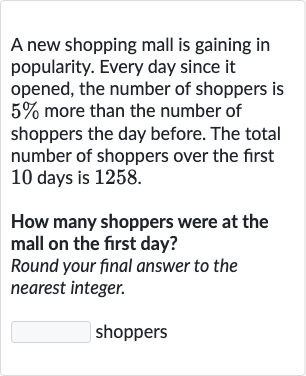AI tutor
Welcome to Bytelearn!
Let’s check out your problem:

A new shopping mall is gaining in popularity. Every day since it opened, the number of shoppers is more than the number of shoppers the day before. The total number of shoppers over the first days is .How many shoppers were at the mall on the first day?Round your final answer to the nearest integer.shoppers
Full solution
Q. A new shopping mall is gaining in popularity. Every day since it opened, the number of shoppers is more than the number of shoppers the day before. The total number of shoppers over the first days is .How many shoppers were at the mall on the first day?Round your final answer to the nearest integer.shoppers
- Denote Shoppers on First Day: Let's denote the number of shoppers on the first day as . Since the number of shoppers increases by % each day, the number of shoppers on the second day would be , on the third day , and so on, up to the tenth day which would be . The total number of shoppers over the first days is given as . We can write this as a geometric series:
- Calculate Geometric Series: The sum of a geometric series can be calculated using the formula:where is the first term, is the common ratio (. in this case), and is the number of terms ( in this case). We can plug in the values to find :
- Apply Geometric Series Formula: Now we solve for :
- Solve for S: We round the final answer to the nearest integer:
More problems from Exponential growth and decay: word problems
QuestionGet tutor help
QuestionGet tutor help
QuestionGet tutor help
QuestionGet tutor help
QuestionGet tutor help
QuestionGet tutor help
QuestionGet tutor help
QuestionGet tutor help
QuestionGet tutor help
